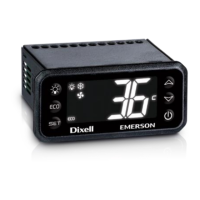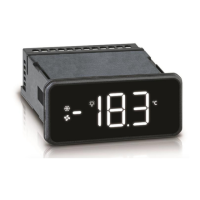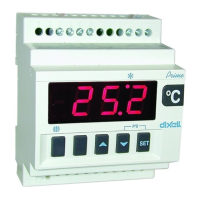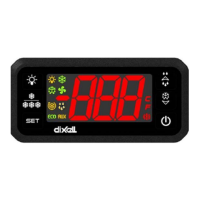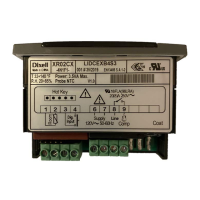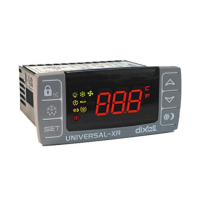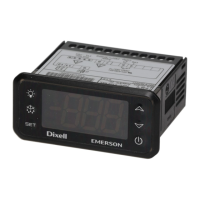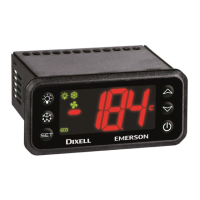1592020670 XRi77CX-CH GB r1.1 15.10.2019 XRi77CX-CH 2/9
3.4.10 REGULATION OUTPUT
If oAx=inV, the related output will work as regulation output and will stay active as soon as the
regulation request is running.
4. PULL DOWN
An automatic function named PULL-DOWN is implemented. This function forces the controller to work
at PMA until reaching a specific SETPOINT (par. CCS) for a maximum interval of time (par. CCt). The
PULL-DOWN function is activated:
At start-up if the temperature measured from the regulation probe is higher than the SETPOINT
After any defrost
If the temperature measured from regulation probe go over the SET+HY+HY1+oHt value.
If one of the above conditions happens, the controller will maintain the maximum compressor speed
(PMA) until reaching the CCS setpoint. The maximum interval of time for any PULLDOWN is defined
from par. CCt.
5. EVAPORATOR FAN CONTROL
The evaporator fan control mode is selected by means of the FnC parameter:
- FnC = C_n: fans will switch ON and OFF with the compressor and not run during defrost
- FnC = o_n: fans will run even if the compressor is off, and not run during defrost
After defrost, there is a timed fan delay allowing for drip time, set by means of the Fnd parameter.
- FnC = C_Y: fans will switch ON and OFF with the compressor and run during defrost
- FnC = o_Y: fans will run continuously also during defrost
The par. FAP is used to select which temperature probe will be used from the evaporator fan regulator.
A specific setpoint (par. FSt) provides the temperature value, detected by the evaporator probe, above
which the fans are always OFF. This is used to make sure circulation of air only if his temperature is
lower than set in FSt-HYF.
5.1 FORCED ACTIVATION FOR FANS
This function, managed by the FCt parameter, is designed to avoid short cycles of fans, that could
happen when the controller is switched on or after a defrost, when the room air warms the evaporator.
If the difference between the evaporator temperature and the room temperature is higher than the FCt
value, the controller will activate the fans. This function is disabled if FCt=0.
5.2 CYCLIC ACTIVATION OF THE FANS WHEN THE COMPRESSOR IS
SWITCHED OFF
When FnC=C-n or C-Y (fans in parallel to the compressor), the fans will be able to carry out on and
off cycles even if the compressor is switched off. The on and off interval of time follow the Fon and
FoF parameters. When the compressor is stopped, the fans will go on working for the Fon time. On
the other side, with Fon=0 the fans will stay always off when the compressor is off.
6. CONDENSER FAN CONTROL
The condenser fan control mode is selected by means of the FCC parameter:
- FCC = C_n: fans will switch ON and OFF with the compressor and not run during defrost
- FCC = o_n: fans will run even if the compressor is off, and not run during defrost
- FCC = C_Y: fans will switch ON and OFF with the compressor and run during defrost
- FCC = o_Y: fans will run continuously also during defrost
The par. FAC is used to select which temperature probe will be used from the condenser fan regulator.
This regulator uses a specific setpoint (par. St2) and differential (par. HY2) to activate and deactivate
the condenser fans:
- If T>St2+HY2 the condenser fans are activated
- If T<St2 the condenser fans are deactivated
The par. FCo can be used to keep the ventilators active for a period after compressor OFF.
7. AUXILIARY REGULATOR
The auxiliary regulator can be be linked to a digital output (relay) for ONOFF regulation.
The parameters used to configure the auxiliary regulators are the following:
Kind of action for auxiliary regulator
Set point for auxiliary regulator
Differential for auxiliary regulator
Probe selection for auxiliary regulator
Auxiliary regulator disabled during any defrost
8. DUAL MAP FEATURE
The controller is programmed with 2 different parameter maps. In this way, it is possible to choose the
right map to meet both LT and NT applications. There are two different way to do this:
- If i1F=nt, it will be possible to change the working map by using the digital input.
- By using the DOWN button, if it is linked to the map changing function. If so, keep it pressed 3
sec to activate the relative function.
9. VARIABLE SPEED COMPRESSOR CONTROL
9.1 FREQUENCY MODE
The controller can drive variable speed compressors with frequency control input. The frequency
output port can issue a frequency signal from 30 to 200Hz, duty cycle=50%. A special cable must be
used in order to connect the frequency output of the controller to the frequency input of the specific
inverter.
- CAB/EM1: cable DD900002 20 for Embraco VNEK/U models
- CAB/SE1: cable DD900002 22 for SECOP NLV models
NOTE:
- An inverter compressor can be completely controlled from the frequency output only.
- Only one compressor can be connected when frequency mode is used
9.2 PARAMETERS
The following parameters are used to set the regulation:
Differential for proportional regulation: (0.1 to 25.5°C; 1 to 45°F)
Frequency output value with compressor stopped: (0 to 50Hz) frequency output
signal when compressor stopped
Minimum compressor speed (in percentage): (0 to PMA)
Maximum compressor speed (in percentage): (PMi to 100%)
Signal output variation (increment) when temperature is increasing: if vdC=FrE
then 1 to 100 Hz, otherwise 10 to 1000 rpm
Signal output variation (decrement) when temperature is decreasing: if vdC=FrE
then 1 to 100 Hz, otherwise 10 to 1000 rpm
Signal output variation (decrement) after any Pull Down: if vdC=FrE then 1 to 100
Hz, otherwise 10 to 1000 rpm
Time with compressor at PMI before stopping regulation: (0 to 999 min)
Compressor speed (in percentage) in case of any error probe: (PMi to PMA)
Continuous mode during Normal Mode: (n; Y)
Continuous mode during Energy Saving Mode: (n; Y)
The value of the par HY1 can normally be set to the same value of par. HY. In this way, the regulation
band will be extended from SET to SET+HY+HY1. The device will activate the regulation when the
measured temperature will go over the SET+HY value and will stop the regulation when the
temperature will reach the SET value. When the regulation is running, the frequency output, and then
the compressor speed, will be calculated in proportional way by using the PMi…PMA band. After
reaching the SET+HY value, the controller will start increasing the frequency output, and then the
equivalent compressor speed, by using the par. voS. The speed increasing will be stopped as soon
as the proportional calculated value (for the compressor speed) hooks the requested value. In case of
temperature decrement and compressor speed higher than the new requested value, the controller will
decrease the compressor speed proportionally by using the vo2 value. After any Pull Down, and in
case of continuous mode regulation (CMn or CME=Y) it is possible to speed up the compressor speed
decrement by using par. vo3. This helps to avoid subfreezing conditions due to high compressor speed
after reaching the regulation setpoint.
After reaching the SET value it is possible to force the compressor speed to Pmi for t1F min.
In case of any regulation probe error, the compressor speed will be set to the value of par. SPi.
It is possible to enable a cyclic or a continuous mode operation both during normal mode or energy
saving mode:
- CMn, CME = Y: after reaching the SETPOINT the VSC will keep on running
- CMn, CME = n: after reaching the SETPOINT the VSC will be stopped (after t1F)
9.3 TEMPERATURE DEADLOCK CONTROL
The controller can detect temperature deadlocks. If the actual speed is not able to reach the
SETPOINT, and if this condition persists for a long interval of time, then the controller will increment
the actual speed until reaching the SETPOINT. A differential (par. th1) and a speed increment (par.
oFS) is used to detect and manage any deadlock condition.
9.4 HOT GAS DEFROST
In case of using hot-gas defrost, it will be possible to set the compressor speed by using par. Aod.
9.5 PULL DOWN
An automatic function named PULL DOWN is implemented. This function forces the controller to work
at PMA until reaching a specific SETPOINT (par. CCS) for a maximum interval of time (par. CCt). The
PULL-DOWN function is activated:
- At start-up if the temperature measured from the regulation probe is higher than the
SET+HY+HY1
- After any defrost
- If the temperature measured from regulation probe go over the SET+HY+HY1+oHt value.
If one of the above conditions happens, the controller will maintain the maximum compressor speed
(PMA) until reaching the CCS setpoint. The maximum interval of time for any PULLDOWN is defined
from par. CCt. At the end of any PULL DOWN it is possible to set an interval of time (par. t1F) with
predefined compressor speed (PMi).
9.6 OIL MIGRATION CONTROL (VALID ONLY FOR VSC)
To avoid oil migration during variable speed compressor operation, a lubrication control is
implemented. If the compressor works with a speed lower than the MnP threshold for tMi time, then
the compressor speed will be increased to PMA for tMA time.
NOTES:
- MnP= PMi to PMA, nu, OFF
- If MnP=nu, then this function is disabled
If MnP=oFF, then the compressor will be stopped for tMA if it works continuously for tMi
9.7 STEP REGULATION: VSD AND ONOFF COMPRESSOR
The following parameters are used to set up the step regulation function:
Step regulation: inverter compressor speed during ton (in percentage)
Step regulation: deactivation of the ONOFF compressor
Step regulation: delay before activation of the second compressor (when T> SET + HY + HY1)
Step regulation: delay before deactivation of the second compressor
Step regulation: minimum operating time of the second compressor
Step regulation: minimum stop time of the second compressor
The step regulation is activated when at least one ONOFF compressor is enabled (oAx=CP1 or CP2)
and oAn=FrE.
The second compressor (the ONOFF one) will be activated when T > SET+HY+HY1.
The ONOFF compressor deactivation follows par. SCd.

